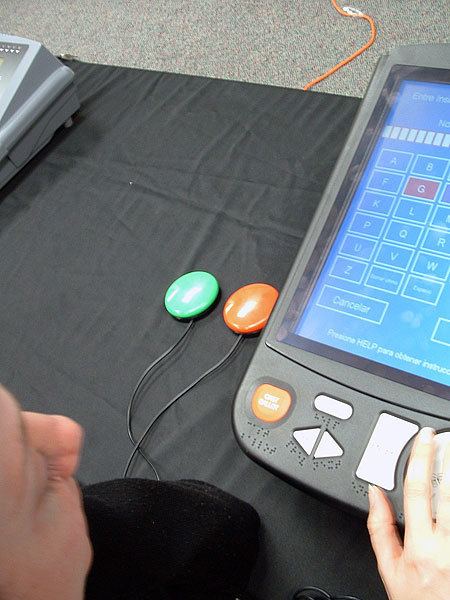 | ||
A direct-recording electronic (DRE) voting machine records votes by means of a ballot display provided with mechanical or electro-optical components that can be activated by the voter (typically buttons or a touchscreen); that processes data by means of a computer program; and that records voting data and ballot images in memory components. After the election it produces a tabulation of the voting data stored in a removable memory component and as printed copy. The system may also provide a means for transmitting individual ballots or vote totals to a central location for consolidating and reporting results from precincts at the central location. The device started to be massively used in 1996, in Brazil, where 100% of the elections voting system is carried out using machines.
Contents
- History
- Benefits of DRE voting machines
- 2009 German court ruling
- Demonstrated laboratory attacks
- References
In 2004, 28.9% of the registered voters in the United States used some type of direct recording electronic voting system, up from 7.7% in 1996.
History
The idea of voting by push button, with electrical technology used to total the votes, dates back to the 19th century, when Frank Wood of Boston was granted a patent on a direct-recording electrical voting machine. (Thomas Edison's electrical voting system patent is sometimes cited in this regard, but it was intended for tallying roll-call votes in legislative chambers; as such, it is more like an audience response system.) The idea of electrical voting was pursued with much more vigor in the 20th century. Numerous patents were filed in the 1960s, many of them by AVM Corporation (the former Automatic Voting Machine Corporation), the company that had a near monopoly on mechanical voting machine at the time.
The first direct-recording electronic voting machine to be used in a government election was the Video Voter. This was developed by the Frank Thornber Company in Chicago. The Video Voter saw its first trial use in 1974 near Chicago, Illinois, and remained in use until 1980
Microvote and Shoup Voting Machine Corporation entered the market in the mid 1980s with the MV-464 and the Shouptronic. Both of these machines saw widespread use; over 11,000 Shouptronic machines had been sold by 1993. In the years that followed, the rights to the Shouptronic were transferred to Guardian Voting, and then to Danaher Controls, which sold it as the ELECTronic 1242.
Benefits of DRE voting machines
Like all voting machines, DRE systems increase the speed of vote counting. They can also incorporate the most broad assistive technologies for the largest classes of handicapped people, allowing them to vote without forfeiting the anonymity of their vote. These machines can use headphones and other adaptive technology to provide the necessary accessibility. DRE's can also provide the most robust form of immediate feedback to the voter detecting such possible problems as undervoting and overvoting which may result in a spoiled ballot. This immediate feedback can be helpful in successfully determining voter intent.
Additionally, with DRE voting systems there is no risk of exhausting the supply of paper ballots, and they remove the need for printing of paper ballots, a significant cost. When administering elections in which ballots are offered in multiple languages (in some areas of the United States, public elections are required to by the National Voting Rights Act of 1965), DRE voting systems can be programmed to provide ballots in multiple languages on a single machine. For example, King County, Washington's demographics require them under U.S. federal election law to provide ballot access in Chinese. With any type of paper ballot, the county has to decide how many Chinese-language ballots to print, how many to make available at each polling place, etc. Any strategy that can assure that Chinese-language ballots will be available at all polling places is certain, at the very least, to result in a lot of wasted ballots.
2009 German court ruling
In 2009, the Federal Constitutional Court of Germany found that with, voting machines the "determination of the result must be able to be examined by the citizen reliably and without any specialist knowledge of the subject." They further found the DRE-type voting machines, used in parliamentary elections under current German law, permitted voting machines but were unconstitutional without further qualification. The decision does not ban electronic voting but implements a higher standard.
Demonstrated laboratory attacks
Attacks have also been performed on both DRE machines and optical scan voting machines, which count paper ballots. (See California study, "Security Analysis of the Diebold AccuBasic Interpreter" ).
Whether it is a DRE or an optical scan machine, the opportunity for tampering applies to persons with inside access (including government workers) and to a lesser extent, outside hackers. Therefore framing election tampering issues as "hacking" may not be an accurate framework for public concerns. Within the context of protecting voting rights, it would not matter whether vote alteration was done by an outsider or an insider. What is of most importance is the ability to perform an audit with a record generated and verified by the voter at the time their vote is cast, all of which is lost with the sole use of these DRE systems.
Aside of particular hacks against particular machines, it is argued that electronic voting using fully digital DRE cannot be made adequately secure.
